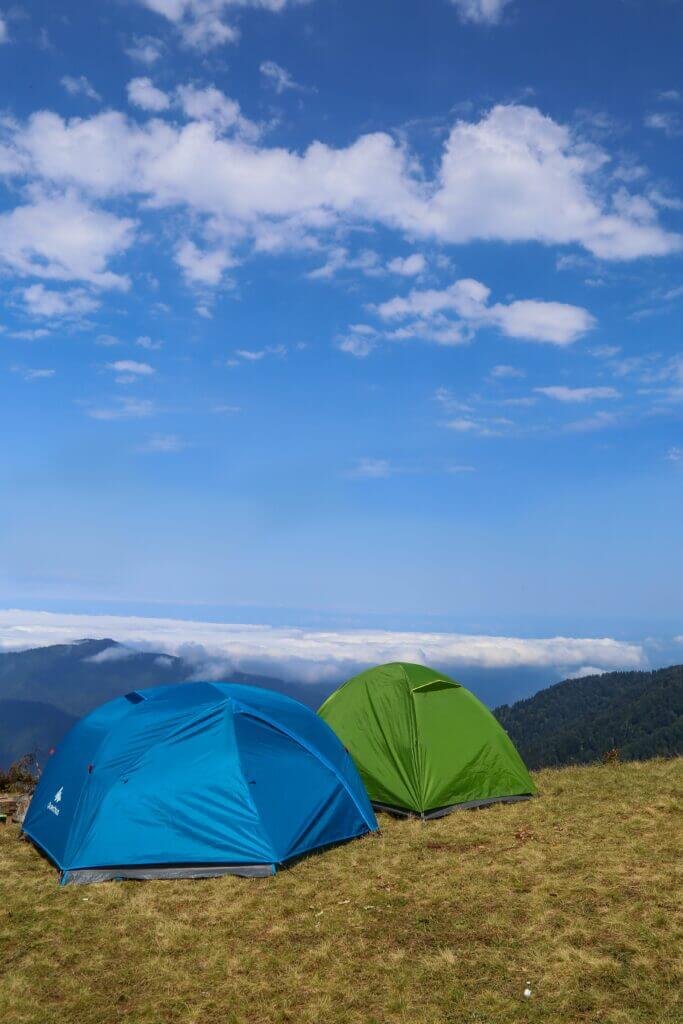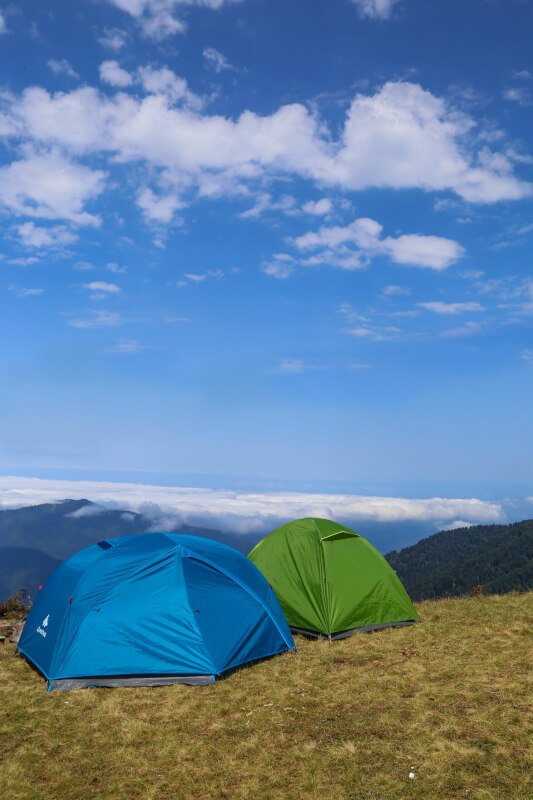Setting up a camping tent may seem like a daunting task, but with a few simple steps, you’ll be pitching like a pro in no time. Whether you’re a seasoned camper or a first-timer, this article will provide you with valuable tips and tricks to ensure that your tent is set up properly. From selecting the ideal campsite to securing the rainfly, we’ve got you covered. So grab your tent and let’s get started on your outdoor adventure!

Choosing the Right Campsite
When it comes to choosing the right campsite, there are a few factors you should consider to ensure a comfortable and safe camping experience. First and foremost, take a look at the terrain and environment of the area. Is the ground level and suitable for pitching a tent? Is the area prone to flooding or rocky terrain? These are important considerations that can greatly impact your overall camping experience.
Another important factor to consider when choosing a campsite is finding a spot that is sheltered from wind and water. Look for areas with natural barriers such as trees or shrubs that can provide some protection from strong winds. Additionally, try to find a spot that is not in a low-lying area where water might accumulate in case of rain.
Taking note of any overhead hazards is also crucial for your safety. Look out for dead or weak branches that could potentially fall during windy conditions, and try to avoid setting up your tent directly underneath them. By being mindful of these factors, you can choose a campsite that provides the best possible conditions for a comfortable and safe camping experience.
Preparing the Tent
Before setting up your tent, it’s important to properly prepare and inspect all the tent components. Unpack your tent and ensure that all the necessary parts are present and in good condition. Check for any tears or damages in the tent fabric, poles, or stakes that might need to be addressed before setting up.
Next, spread out the tent footprint or groundsheet. This serves as an additional protective layer between the tent floor and the ground, preventing moisture from seeping into the tent and also reducing wear and tear on the tent floor. Lay it flat and align it with the shape of the tent.
After the footprint is laid out, begin assembling the tent poles and stakes. Follow the instructions provided with your tent to ensure proper assembly. Make sure the poles are securely connected and the stakes are in good condition. This step is essential before moving on to setting up the tent.
If your tent comes with a rainfly, attach it to the tent body before proceeding to the next step. The rainfly provides an extra layer of protection against rain and can help keep the interior of your tent dry during wet weather conditions.

Setting Up the Tent
Now that you have prepared all the necessary components, it’s time to set up your tent. Lay out the tent body on top of the footprint, making sure to align the corners and edges. This will provide a clear framework for assembling the poles.
Next, insert the tent poles through the designated sleeves or clips. Be careful not to force the poles or bend them in the wrong direction as this may cause damage. Once the poles are inserted, raise the tent by standing the poles upright and connecting them at the top. This will give your tent its full shape and structure.
Finally, secure the tent to the ground using stakes. Start with the corners and then attach the guylines at points where additional stability is needed. Push the stakes firmly into the ground at a slight angle, making sure they are securely anchored. This will help prevent the tent from shifting or collapsing in windy conditions.
Securing the Tent
To ensure your tent remains secure throughout your camping trip, it’s important to properly stake it down and create tension in the tent fabric. Once the tent is set up, stake down the corners and guylines to prevent the tent from shifting or being lifted by strong winds. This will provide added stability and prevent any potential accidents.
Creating tension in the tent fabric is another important step. To do this, adjust the guylines connected to the tent corners and pull them tight. This will help to evenly distribute the tension across the tent, ensuring a sturdy and secure structure. Make sure to regularly check and readjust the stakes and guylines as needed, especially after any changes in weather conditions.
In addition to staking and creating tension, it’s worth considering using additional methods to secure the tent. This might include using rocks or logs as natural anchors, or utilizing tent anchors or sandbags for added stability. By taking these extra precautions, you can have peace of mind knowing that your tent is securely anchored.

Organizing the Interior
Now that your tent is secure, it’s time to organize the interior to maximize comfort and efficiency. Start by placing a groundsheet or tarp inside the tent. This will provide an extra layer of insulation and help keep the tent floor clean and dry. Make sure the groundsheet is slightly smaller than the tent footprint to prevent water from collecting between the layers.
Next, arrange your sleeping bags and camping mats. Place them in a way that allows everyone to have their own space while maximizing the available floor area. Sleeping bags can be arranged in a row or diagonally, depending on personal preference.
To create a well-organized tent, consider setting up storage compartments and organizers. Hanging storage pockets or gear lofts can be attached to the tent walls, providing convenient spaces to store small items such as flashlights, phones, or books. This will help keep the interior tidy and prevent clutter.
Finally, designate specific areas for different activities within the tent. This might include a designated sleeping area, a space for changing clothes, and a separate area for storing gear. By creating these different zones, you can make the most of your tent’s interior space and ensure a well-organized camping experience.
Maximizing Comfort and Safety
Ensuring proper ventilation inside your tent is essential for your comfort and safety. Make sure the tent vents are open to allow for adequate airflow, which can help reduce condensation and prevent the interior from becoming stuffy. If your tent has multiple windows or doors, consider leaving some open to enhance ventilation.
Using a tent footprint or groundsheet underneath your tent provides additional comfort and protection. It acts as a barrier against moisture and keeps the tent floor clean. By using a footprint, you can also extend the lifespan of your tent by reducing wear and tear on the floor fabric.
Remember to always close the tent entrance properly when entering or exiting. This will help to keep insects, bugs, and other critters outside. It’s also a good practice to take off your shoes or boots before entering the tent to prevent dirt and debris from being tracked inside, which can help keep the interior clean and comfortable.
In case of inclement weather, consider using a rainfly for added protection. A rainfly can prevent rain from seeping through the tent fabric and also provide additional shade on hot sunny days. Make sure the rainfly is properly attached and adjusted to provide maximum coverage for your tent.
Dealing with Tent Issues
While proper preparation and maintenance can prevent many tent issues, it’s important to know how to address common problems that may arise during your camping trip. One common issue is leaks or tears in the tent fabric. If you notice any leaks, use waterproof sealant or tape to patch them up. For tears or damages that cannot be repaired, it may be necessary to replace the damaged tent components.
Don’t be afraid to reseal the tent seams if necessary. Over time, the seam sealant applied to your tent may wear off or deteriorate. To maintain the waterproof integrity of your tent, it’s recommended to regularly check the seams and reapply sealant as needed.
After your camping trip, it’s important to clean and store your tent properly. Make sure the tent is completely dry before packing it away to prevent mildew or mold growth. Fold or roll the tent body and rainfly neatly to minimize any creases that could cause damage. Store all the tent components in a dry and cool place to prolong their lifespan.
Maintaining a Clean Campsite
One of the key responsibilities of every camper is to maintain a clean campsite. Practicing responsible waste management is crucial to minimize your impact on the environment. Bring garbage bags and separate your trash into different categories such as recyclables, non-recyclables, and food waste. Dispose of them properly in designated areas or bins provided by the campground.
It’s important to keep food stored properly and away from your tent to prevent attracting unwanted guests such as bears or rodents. Use sealed containers or coolers to store your food and keep it secure.
When leaving the campsite, make sure to leave it as clean as or cleaner than you found it. Pick up any trash or litter in the immediate area, including small pieces of paper or plastic. Take the time to properly dispose of leftover food or perishables to avoid attracting wildlife.
By practicing these responsible habits, you can help maintain the beauty of nature and ensure that future campers can enjoy a clean and pristine environment.
Taking Down the Tent
When it’s time to pack up and leave the campsite, there are a few steps to follow to properly take down your tent. Start by removing the stakes and guylines from the ground. Carefully pull them out to avoid damaging the tent fabric or bending the stakes.
Next, disconnect and collapse the tent poles. Follow the instructions provided with your tent to ensure the poles are properly collapsed and stored. Avoid forcing or bending the poles as this can cause damage and affect their functionality.
Before packing away the tent, make sure it is dry and free from any debris. Shake off any dirt or leaves and wipe down the interior with a clean cloth if necessary. This will help prevent the growth of mold or mildew during storage.
Once the tent is clean and dry, fold or roll it back to its original size. It’s a good idea to follow the same folding or rolling technique you used when you first unpacked the tent. This will make it easier to fit the tent back into its storage bag or container.
Take care to pack all the tent components properly. Make sure the stakes, guylines, rainfly, and other accessories are neatly stored and secured. This will help you stay organized and ensure that everything is ready for your next camping adventure.
Tips and Recommendations
To make your camping experience even better, here are a few additional tips and recommendations:
- Set up the tent before your camping trip to familiarize yourself with the assembly process. This will help save time and ensure a smoother setup at the campsite.
- Practice setting up the tent at home first. This will give you the opportunity to troubleshoot any potential issues and become more proficient in the setup process.
- Bring a mallet for easier stake insertion. Sometimes the ground can be hard or rocky, making it difficult to push stakes in. Using a mallet can make this task much easier.
- Consider bringing extra stakes and guylines. Accidents can happen, and having spare stakes and guylines can be a lifesaver in case any get damaged or lost during your trip.
By following these tips and recommendations, you can enhance your camping experience and ensure a trouble-free setup and takedown of your tent. Remember, a well-prepared and properly set up tent provides the foundation for an enjoyable outdoor adventure.


